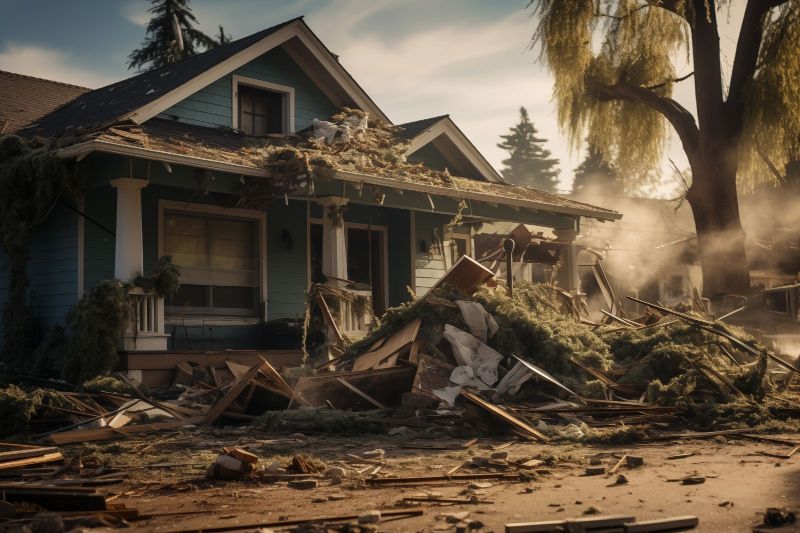Storms, whether they are hurricanes, tornadoes, or severe thunderstorms, have the potential to wreak havoc on homes and communities. The aftermath of a storm can be overwhelming, with property damage, debris, and emotional distress. In this blog post, we'll explore the challenges of storm damage recovery and provide insights on how to navigate the restoration process to restore not just your property but also your peace of mind.
- The Emotional Toll of Storm Damage: Beyond the Physical Impact:
Storm damage goes beyond the visible destruction; it can take an emotional toll on homeowners. Dealing with the aftermath, navigating insurance claims, and facing the uncertainty of the restoration process contribute to the stress and anxiety that often accompany storm damage.
- Safety First: Assessing and Mitigating Immediate Risks:
After a storm, safety should be the top priority. Assess your property for immediate risks such as structural damage, downed power lines, or gas leaks. Evacuate if necessary and only return once it's safe to do so.
- Documenting Damage: A Crucial Step in the Recovery Process:
Documenting the storm damage is essential for insurance claims. Take photographs and make a detailed list of the damage, including structural issues, damaged belongings, and any immediate hazards. This documentation will be valuable when working with insurance adjusters.
- Contacting Your Insurance Company: Navigating the Claims Process:
Contact your insurance company as soon as possible to initiate the claims process. Provide them with the documented evidence of the damage and follow their instructions for inspections and assessments. Understanding your policy and asking questions can help streamline the claims process.
- Professional Assessment: Evaluating the Extent of Damage:
Engage professionals to assess the extent of the storm damage. Structural engineers, roofing experts, and restoration professionals can provide comprehensive assessments, helping you prioritize repairs and restoration efforts.
- Temporary Repairs: Preventing Further Damage:
Implement temporary repairs to prevent further damage while awaiting major restoration work. Tarping roofs, boarding up windows, and addressing immediate safety concerns are crucial steps in protecting your property from additional harm.
- Debris Removal: Clearing the Path to Recovery:
Storms often leave behind a trail of debris. Efficient debris removal is vital for both safety and the restoration process. Engage professional debris removal services to clear your property and facilitate a smoother recovery.
- Structural Repairs: Rebuilding the Foundation:
Once the immediate risks are mitigated, focus on structural repairs. Engage licensed contractors to rebuild and repair damaged structures. This may include roofing, siding, windows, and any other structural elements compromised during the storm.
- Interior Restoration: Bringing Your Home Back to Life:
Interior restoration involves addressing damage to your home's interior, including flooring, walls, and electrical systems. Professionals in water damage restoration, mold remediation, and general contractors can work together to restore your home's interior.
- Emotional Support: Recognizing the Impact on Well-being:
Acknowledge the emotional toll of storm damage and seek support. Engage with friends, family, or professionals who can provide emotional support during the recovery process. Remember that restoring your peace of mind is just as important as restoring your property.
Case Study:
Imagine a coastal community hit by a hurricane that caused extensive damage to homes. A family, facing the emotional distress of seeing their property in ruins, worked with restoration professionals, engaged their insurance company promptly, and implemented temporary repairs. With a clear plan, they navigated the restoration process, addressing structural and interior damage. By leaning on their support network and focusing on both the physical and emotional aspects of recovery, they were able to restore not just their home but also their peace of mind.
Storm damage recovery is a challenging journey that requires a combination of practical steps and emotional resilience. By prioritizing safety, documenting damage, engaging professionals, and seeking emotional support, homeowners can navigate the restoration process more effectively. Restoring your property after a storm is not just about rebuilding walls and roofs; it's about rebuilding lives and restoring a sense of normalcy. With a comprehensive approach to recovery, you can not only reclaim your home but also find peace of mind in the midst of the storm's aftermath.

